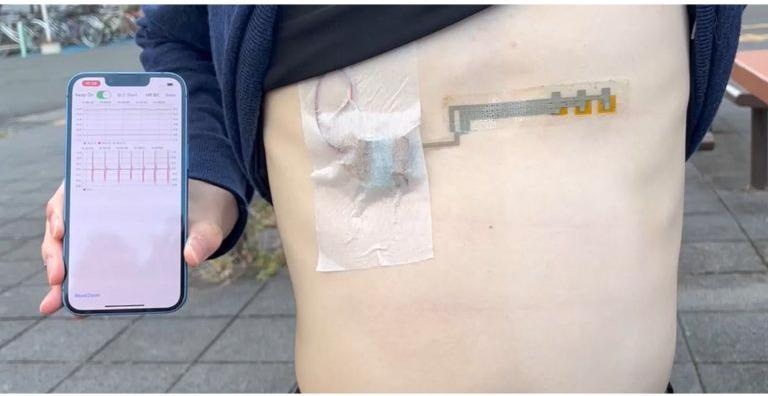Sensors are increasingly having to fit the curves of the body as improvements in wearable gadgets boost the amount of information they can supply users. The concepts of kirigami are used in one technique to give sensors more flexibility.
 Wireless, wearable, and flexible electrocardiogram monitor with app data. Image Credit: Kuniharu Takei.
Wireless, wearable, and flexible electrocardiogram monitor with app data. Image Credit: Kuniharu Takei.
Researchers want to use the centuries-old craft of cutting paper into shapes to create a flexible sensor sheet that can stretch and breathe with the skin while recording electrocardiographic data. The sensor, developed by Japanese researchers and published in Applied Physics Reviews by AIP Publishing, uses cuts in a film made of polyethylene terephthalate (PET) imprinted with silver electrodes to fit over a person’s chest to track his or her heart.
In terms of wearability, by applying kirigami structure in a PET film, due to PET deformation and bending, the film can be stretchable, so that the film can follow skin and body movement like a bandage. In addition, since kirigami structure has physical holes in a PET film, skin can be easily breathed through the holes.
Kuniharu Takei, Study Author, Department of Physics and Electronics, Osaka Prefecture University
Unlike the closely related art of origami, which focuses solely on paper folding, kirigami includes paper cutting as well. This method enables relatively rigid materials, such as PET, to adjust to their surroundings.
As firms move towards less apparent wearables, the focus has shifted to improving the ability to distinguish electrical impulses from the heart from background noise. Devices that assure a tighter fit, such as the groups, are an interesting solution.
The ideal sensor size, according to the researchers, is 200 square millimeters with 1.5 centimeters between electrodes. Researchers were able to identify enough cardiac signals at that size to be utilized in a smartphone app.
The major challenge was how to realize the kirigami structure without using a precise alignment process between the silver electrodes and kirigami cutting.
Kuniharu Takei, Study Author, Department of Physics and Electronics, Osaka Prefecture University
Their sensor-equipped device could properly and reliably communicate cardiac data across numerous persons performing a variety of activities such as walking or working while seated in a chair.
The group’s next goal is to add more sensors that can monitor a variety of data from the skin’s surface to assist in disease detection and future medical trials.
We understand that the new mechanism or new material developments makes better impact to the field. However, without improving the stability, it cannot be used for the practical applications, even if the sensor performance is excellent.
Kuniharu Takei, Study Author, Department of Physics and Electronics, Osaka Prefecture University
Journal Reference:
Xuan, Y., et al. (2022) Wireless, minimized, stretchable, and breathable electrocardiogram sensor system. Applied Physics Reviews. doi.org/10.1063/5.0082863.